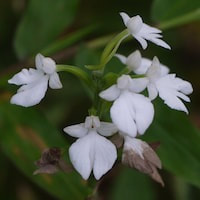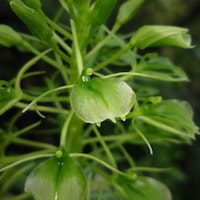MWD8- Men's Woody 8 - For those who scent the rules
|
Native Singaporean Orchid notes: Encyclia Polybulbon
Encyclia polybulbon, used in the Woody 8 (Men) perfume workshop for team building, is not native to Singapore but originates from the Caribbean islands like Cuba, Jamaica, Guatemala, Honduras, and parts of Mexico such as Chiapas, Oaxaca, Puebla, and Veracruz. It typically grows in oak or mixed forests at elevations of 600 to 2000 meters, often as an epiphyte or sometimes on rocks. Its inclusion in the workshop is solely for its fragrance, which combines the aromas of sandalwood with subtle hints of cloves, creating a unique olfactory experience.
|
Therapeutic Orchid notes:
|
Ponerorchis chusua, (D. Don) Soo syn. Ponerorchis chusua var. nana (King & Pantl.) R.C.Srivast.
Guang bu xiao hong men lan, a terrestrial orchid, thrives in the alpine scrublands of Sichuan Province's Huanglong area at elevations of 2800 to 3600 meters. Known scientifically as Ponerorchis chusua, it's also used in India for medicinal purposes, particularly its tubers, which treat ailments like diarrhea, dysentery, and chronic fever. However, in its native China, where it's most commonly found, there are no reported medicinal uses documented for this plant. |
|
Habenaria plantaginea Lindl.
Habenaria plantaginea, known locally as Kusuma gadda in Bangladesh, is a widespread species found in dry zone forests across Sri Lanka, India (below 900 meters), Bhutan (1000 to 2500 meters), Myanmar, and the Lesser Sunda Islands. Its tubers are used in herbal medicine to treat wasting diseases, fever, blood disorders, hemorrhages, and fainting. In the Eastern Ghats of Andra Pradesh, a paste made from these tubers, black pepper, and garlic is formed into tablets used for relieving chest pain and stomachaches. Similar practices are observed in Bangladesh for treating these ailments. |
|
Anacamptis coriophora
Anacamptis coriophora, commonly known as the Bug orchid, features small flowers ranging from green to deep wine-red, with joined tepals forming a hood over the column. It belongs to orchid species known for producing p-hydroxybenzyl alcohol, a compound found in terrestrial and mycoheterotrophic orchids. In studies on rats, p-hydroxybenzyl alcohol and gastrodin aid in memory consolidation and retrieval. Additionally, this compound has skin-whitening effects by inhibiting tyrosinase, the enzyme responsible for melanin production in skin. |
|
Anoectochilus formosanus Hayata
Anoectochilus formosanus, known by various Chinese and Taiwanese names like Jinxian Lan and Taiwan jewel orchid, thrives in Taiwan's forests and bamboo areas from 500 to 1500 meters, also found in the Ryukyu Islands. In Traditional Chinese Medicine (TCM), the whole plant is used for cooling blood, liver smoothing, fever reduction, and detoxification. It treats diverse ailments such as tuberculosis, diabetes, bronchitis, and kidney infections. Researchers in China and Tokyo identified several beneficial compounds in the orchid, including quercetin derivatives and kinsenoside, known for its liver-protective properties. |
|
Bletilla Ochracea
Bletilla ochracea, known as Huanghua Baiji in Chinese, contains phenanthrenes that exhibit antimicrobial properties effective against three types of Gram-positive bacteria: Staphylococcus aureus, S. epidermidis, and Bacillus subtilis. These compounds are recognized for their ability to combat bacterial infections caused by these organisms. Bletilla ochracea is valued for its medicinal potential in traditional practices where its antimicrobial attributes are utilized to treat various conditions associated with these bacteria. |
|
Liparis cordifolia Hook. f. Syn. Liparis argentopunctata Aver., Liparis keitaoensis Hayata
Liparis cordifolia, also known as Xinyeyangersuan or Silver cricket orchid in Chinese, is associated with the synthesis of two alkaloids, keitaonine and keitine, primarily found in L. keitaoensis. Keitaonine, a pyrrolizidine-based alkaloid, is an ester of 3-methoxy-malaxinic acid and laburnine. Keitine, potentially absent in the live plant, serves as the aglycone of keitaoine. In Taiwanese herbal medicine, a root decoction of this orchid is used to alleviate abdominal pain, highlighting its traditional medicinal application. |
Other scent note
Rosewood, cedar wood and incense mix
Scentopia Library Reference ingredient
Download the guided mediation that works best with this Orchid fragrance oil
| men_woody_essential_oil_orchi_00008.mp3 | |
| File Size: | 114032 kb |
| File Type: | mp3 |






